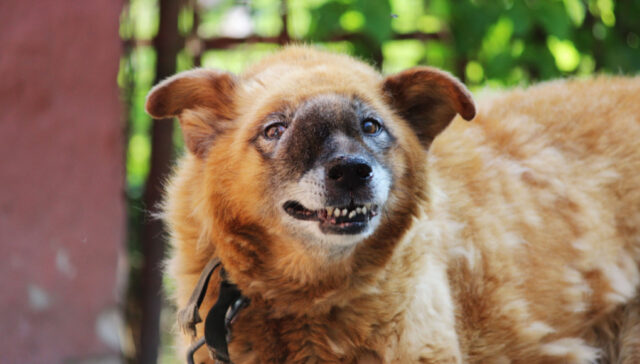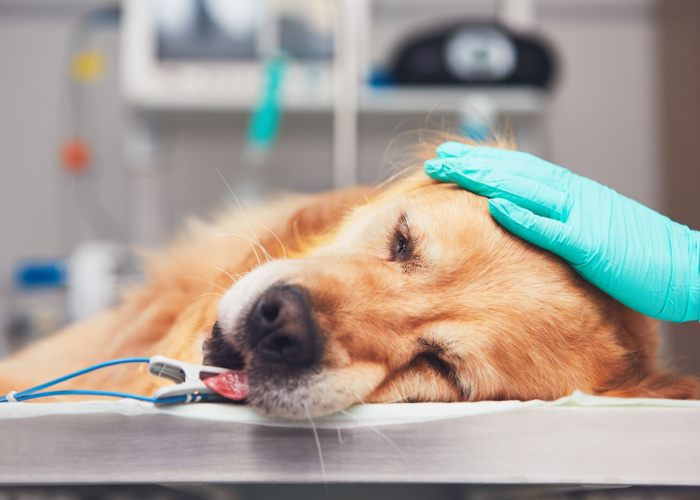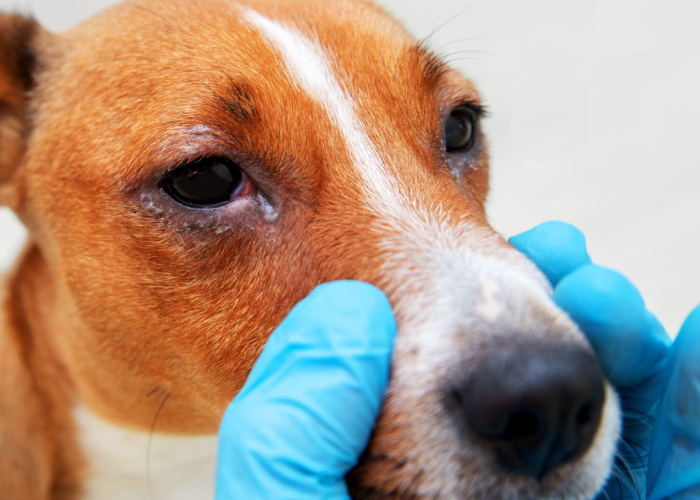
Table of Contents
Did you know that older dogs are more prone to develop nasal tumors?
And without supportive care, a study finds that:
…euthanasia is generally elected within a few months due to progression of local disease.
Unfortunately, nasal tumors in dogs cannot be treated.
However, there are plenty of ways to help prevent your dogs from acquiring one.
So, I made sure to include that in today’s blog. (Must read!)
To help you navigate the page, refer to this guide below:
- Understanding nasal tumors in dogs
- Vital FAQs about dogs with nasal tumors
- Preventive measures against tumors in dogs
Let’s dig in!

What are nasal tumors in dogs?
Tumors, in a general context, refer to the grouping of abnormal cells that develop into a solid mass of tissue.
This phenomenon can occur in the bone, skin, glands, organs, and other tissues in humans and animals.
In nasal tumors in dogs, the uncontrolled production of cells in the nasal airway causes breathing difficulty and other complications.
What causes nasal tumors in dogs?
The causes of nasal tumors in dogs are unknown.
Although experts suggest that there is a possible complex mix of factors why this occurs in canines, including:
- Genetics
- Living conditions
- Underlying health problems
What are the signs of nasal tumors in dogs?
The signs of nasal tumors in dogs include the following:
- Coughing
- Weight loss
- Noisy breathing
- Facial deformities
- Decreased appetite
- Pus-like nasal discharge
- Lethargy or extreme weakness
- Bleeding from one or both nostrils
On rare occasions, your dogs can also suffer from neurological symptoms, such as:
- Seizures
- Walking in circles
- Behavior changes
- Sudden onset of blindness
How do you diagnose a nasal tumor in dogs?
To diagnose nasal tumors in dogs, your vet uses tools and procedures such as the following:
- MRI
- X-ray
- CT scan
Computerized tomography or CT scan is an ideal way to tell the presence and severity of the tumor.
Magnetic resonance imaging, or MRI, on the other hand, is also suitable to use because it can determine the size and location of the tumor.
In case of routine staging or searching for potential spread to other locations in the body, your vet can proceed with the following procedures:
- Urinalysis
- Abdominal ultrasound
- Complete blood cell count
- Repeat X-raysor CT scan of the lungs
- Chemistry profile to check organ function
In other cases, your vet may proceed with fine needle aspiration (FNA) or suctioning a sample of cells directly from the lymph node through a small needle with a syringe.
Can nasal tumors in dogs be cured?
Nasal tumors in dogs are not curable; however, certain treatments can reduce the symptoms.
Some experts suggest that “treatment for nasal tumors depends on the specific type of tumor.”
Other findings also claim that “radiation therapy can achieve clinical remission with good quality of life.”
To add, this study also highlights the following:
…toceranib phosphate decreases the clinical signs associated with nasal carcinomas.
Toceranib phosphate is an antineoplastic/anticancer medication used to treat mast cell tumors in dogs.
It’s still best, however, to consult your vet regarding your dog’s treatment for a proper assessment.

Nasal Tumors in Dogs: FAQs
How fast does a nasal tumor in dogs grow?
Nasal tumors in dogs have a low tendency to spread in other parts of their body, although a higher chance of spreading can occur locally.
If your dog has other underlying diseases, complications may arise, too.
Are nasal tumors in dogs painful?
Nasal tumors in dogs are often painful, especially because it affects the cavity and airways.
In severe cases, nasal tumors also affect the brain since the cavity is located close to the head.
What are the side effects of dog nasal tumor treatment?
The side effects of nasal tumors in dogs are usually minimal, which can include the following:
- Peeling of the skin
- Change in fur color
- Ulceration or skin condition that discharges pus, blood, or fluid.
Skin infections and burn-like side effects are temporary.
So, you can help treat these skin irritations with antibiotics and anti-inflammatory medications.
Apart from that, the tear gland can also be compromised, resulting in dry eye.
This, however, depends on how close the tumor is to your dog’s eyes.
How long can a dog live with a nasal tumor?
Depending on their general condition and treatments received, dogs with nasal tumors can live about 3 to 5 months.
In severe cases where tumors develop into cancer, a study finds that dogs have an average survival time of 2 months.
Interestingly, the same study also found that dogs that experience nosebleeding have a longer survival time of almost 3 months.
Meanwhile, those pups that didn’t nosebleed have only about 1 month to live.
What is the most common nasal tumor in dogs?
Adenocarcinoma is the most common type of nasal tumor in dogs that comes from the glandular cells or the lining of the internal organs.
This type of malignant (cancerous) tumor growth can occur in many parts of the body, including the gastrointestinal system of dogs.
And similar to most cancers, adenocarcinoma’s causes are also unknown.
Treating this condition often involves surgery or alternatives like chemotherapy and anti-inflammatory medications.

How do you prevent nasal tumors in dogs?
Preventing nasal tumors in your dogs can be tricky since this condition is often linked to genetics.
The quality of life and other external factors may also come into play.
And especially since tumors and cancers are close relatives, you need to acquaint yourself with the right diet for your dog.
So, here are some anti-cancer superfoods to consider to encourage a healthy lifestyle for your pup:
1. Broccoli
This chunky green is home to loads of fiber, vitamins, and minerals for your dog’s optimal health.
Not just that, broccoli also contains biochemicals that help protect your furry friend from cancer.
Glucosinates are phytochemicals present in broccoli that break down into biologically active compounds, making carcinogens inactive.
This phytochemical also has the following benefits besides beating cancer up:
- Prompts cell death in tumors
- Protects cells from DNA damage
- Prevents the formation of tumor blood vessels
Sulforaphane and other natural compounds found in broccoli can also stop cancer cells from forming in your dog’s body.
Before feeding broccoli to your dogs, take note of the following tips first:
- Start feeding your dogs broccoli stems before giving them the florets. The florets (topmost part) can give your pups gas due to stomach irritation.
- Lightly steam your broccoli stems and florets to release the cancer-fighting enzyme. This also makes it easier for your dog to digest.
2. Sweet Potatoes
Not only enjoyed by hoomans but adored by your furballs, too!
Thanks to its sweet-savory taste, your pups can munch on this healthy treat and help fight cancer simultaneously.
That’s because of the unique blend of vitamins and minerals, such as carotenoids and beta-carotene, that reduce the risk of cancer development.
Before feeding sweet potatoes to your dogs, take note of the following tips first:
- Cook or bake sweet potatoes until they are tender enough to eat.
- Cut into small cubes or mash them before adding them to your dog’s bowl.
But wait, did you know?
“Sweet potato peel, which is usually discarded as waste, contains constituents that can serve as dietary components to prevent the development of different types of cancer.” (Source)
3. Pumpkin
Just like sweet potatoes, pumpkins are also rich in beta-carotene, as seen in their bright orange color.
To help fight cancer, beta-carotene converts into vitamin A in the body upon ingestion.
Vitamin A then acts as an antioxidant that reduces the risk of cancer growth by preventing cell damage caused by free radicals.
Antioxidants also help pups (esp. police or therapy dogs) protect and boost their immune system, says a study.
So, before feeding pumpkins to your dogs, take note of the following tips first:
- You can feed your pups cooked (recommended) or canned pumpkin.
- Avoid feeding pumpkin pie filling to your dogs. It’s high in sugar.
- You can also mix pumpkin powder on your dog’s food.
- Add small amounts to your dog's diet. A tablespoon that’s mixed into their regular food is a good start.
Related: Can Dogs Eat Pumpkin Seeds?
4. Dark Berries
“Berries inhibit tumor initiation events by influencing carcinogen metabolism, resulting in reduced levels of carcinogen-induced DNA damage.”
Blueberries and blackberries, says a study, contain anti-inflammatory properties that are critical in cancer prevention and treatment.
Thanks to anthocyanins, this fruit’s prominent rich color or dark pigments contribute to your pup’s health.
Besides the antioxidants that prevent cell damage, dark berries also contain ellagic acid.
This property blocks metabolic pathways that can lead to cancer in your dogs.
So, before feeding dark berries to your dogs, take note of the following tips first:
- You can give fresh or frozen dark berries to your pups as treats.
- You can also mix this fruit with other foods.
- Best to introduce dark berries gradually to avoid stomach upsets.
Related: Recipe: Quinoa and Blueberry Homemade Dog Food
5. Pitted Fruits
Peaches and plums are another great example of pitted fruits that have amazing benefits in fighting cancer.
These pitted fruits are high in antioxidants and work well to remove toxins from your pup’s body.
Not only that, peaches and plums are also packed with the following benefits:
- Iron
- Fiber
- Vitamin C
In promising studies (1, 2) conducted by experts, plums and peaches were found to be the:
“…major source of some important antioxidant substances and are commonly used against cancer and some other cardiovascular diseases.”
These pitted fruits also stop the growth of cancer cells due to their “amygdalin-containing extracts.”
Before feeding pitted fruits to your dogs, take note of the following tips first:
- Remove the pits before feeding your dog peaches and plums. The fruit’s pits contain small traces of cyanide, so get rid of it.
- You can feed fresh or frozen peaches or plums to your dog in small quantities as occasional treats.
6. Fish and Fish Oil
Believe it or not, your dogs need oily fish from time to time.
Why, though?
That’s because the nutrients that fish contains are difficult to find in other food sources.
So, what makes fish a superfood for dogs? Here’s a list of nutrients they contain:
- Vitamin B2
- Vitamin D3
- Eicosapentaenoic acid
- Docosahexaenoic acid
- Omega 3 essential fatty acids
The vitamin D3 in fish and fish oil is what makes these food sources ideal for fighting or preventing cancer in your dogs.
On the other hand, omega-3 is a fatty acid that shrinks tumors, fights cancer, and also reduces inflammation.
That’s, of course, backed by a study that states:
“…the beneficial effects of omega-3 LC PUFA supplementation have been found to reduce heart disease, chronic renal failure, cancer, atopic dermatitis as well as degenerative joint diseases.”
Other promising benefits of feeding fish and fish oil in your dogs are the following:
- Fight skin dryness
- Act as a pain reliever
- Help keep coats shiny
- Support muscle, heart, gut, and brain health
So, if you want to add fish to your pup’s diet, here’s some to help you get started:
- Cod
- Herring
- Salmon
- Sardines
- Mackerel
Before feeding fish and fish oil to your dogs, take note of the following tips first:
- Wild-caught fish is a better choice than farmed due to less contamination with harmful pollutants.
- Feed your dog cooked fresh (recommended) or canned fish.
- Do not season the fish.
Related: Recipe: Fish and Veggie Omelet for Dogs
7. Coconut Oil
This superfood is popular for its many benefits in both hoomans and dogs, including the following:
- High in antioxidants
- Reduces inflammation
- Blocks absorption of cholesterol
- Lowers cardiac risks related to cancer in dogs
- Increases absorption of fat-soluble nutrients (i.e., vitamins A, D, E, and K)
As an anti-cancer agent, coconut oils contain fatty acids and plant sterols that mimic blood cholesterol.
This ability can then help block cholesterol absorption in your dog’s body.
Coconut oil is also good for your pup’s skin and can clear up pre-cancerous lesions, protecting cancerous growths.
What’s more, this superfood is also known to be antibacterial.
Meanwhile, a study finds that food formulas containing coconut oil showed an:
“…increased percentage of body fat, which is a desirable outcome for underweight cancer patients but not necessarily for those who are overweight or obese.”
But before feeding coconut oil to your dogs, take note of the following tips first:
- Consider the size of your dog before feeding coconut oil.
- If your dog is big, give it a smaller amount or offer it less often.
- For smaller dogs, give 1/4 teaspoon of coconut oil a day.
- Consult your vet for a proper assessment.

Nasal Tumors in Dogs: Before You Go…
This condition in your dogs may be incurable, but your love and care for them should continue to flourish.
Because the truth is, your dogs can’t live on their own without a helping hand.
Unfortunately, diseases like nasal tumors in dogs can limit their opportunity to live longer and fuller with you.
So, if you’ve got time to spend and help your pups live happily, adequate living conditions and a proper diet count a lot.
Don’t forget, these factors also help prevent your dogs from acquiring tumors or cancers.
Found this blog helpful? Check out our top recommendations below.












